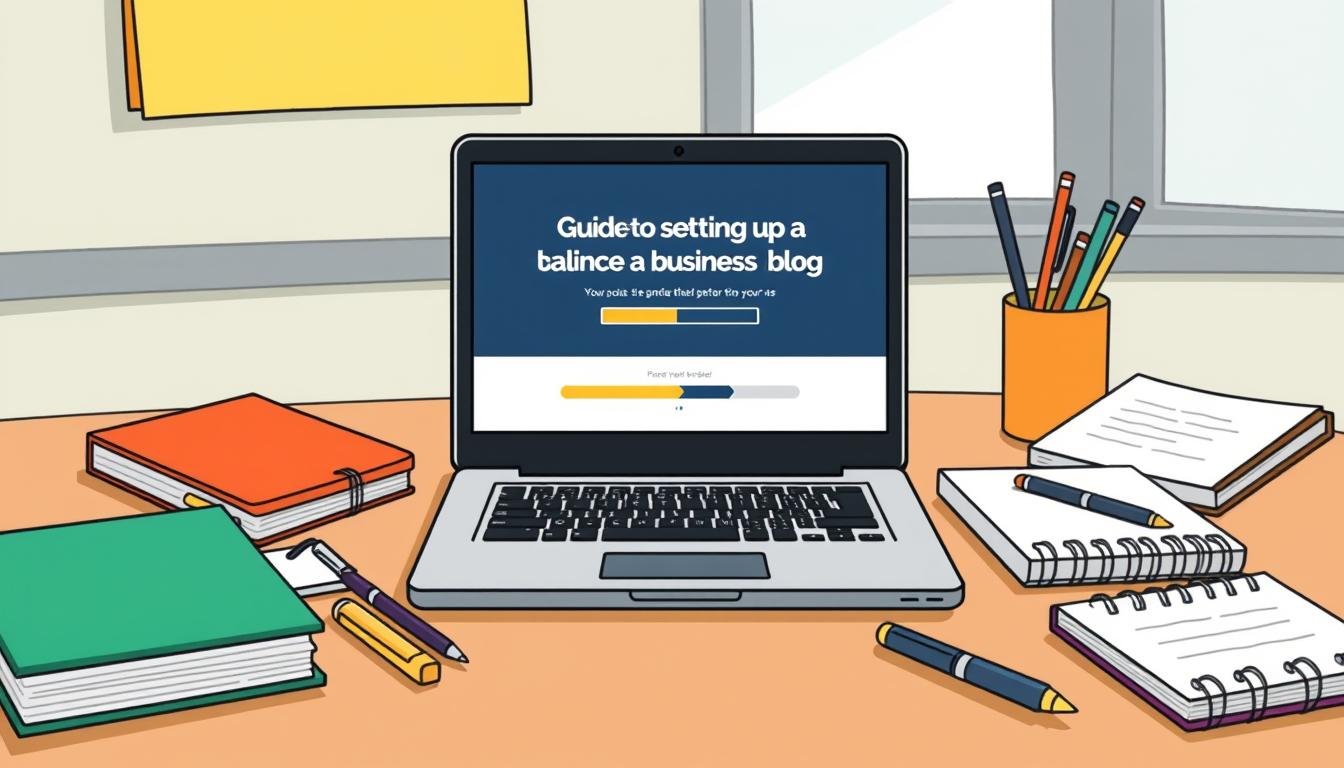Guide to Setting Up a Business Blog
Did you know setting up a blog can take just 10 to 15 minutes? In 2024, starting a blog is easy, even for those without tech skills. A business blog helps companies connect with customers, show off their knowledge, and get noticed.
Over 60% of blogs use WordPress, and services like Bluehost are popular choices. Starting a blog is now affordable, costing about $34.50 to $65.40 in the first year.
This guide will help you set up a business blog step by step. You’ll learn how to find your audience, define your blog’s purpose, and choose the right platform and hosting. In 20 minutes, you can start a blog that grows your online presence and could even make money.
Key Takeaways
- Setting up a blog can take as little as 10 to 15 minutes.
- Over 60% of blogs prefer using WordPress as their platform.
- The initial cost to start a blog in 2024 ranges from $34.50 to $65.40.
- Bluehost is highly recommended for web hosting services.
- Even part-time bloggers can achieve profitability if done right.
- Choosing a memorable domain name is crucial for your blog’s success.
What is a Business Blog?
A business blog is a special part of a website or its own site. It shares insights, updates, and valuable info about a certain topic. It helps businesses connect with potential customers and show they know their stuff.
With 600 million active blogs, the competition is tough. A good business blogging guide helps companies stand out. Having a blog boosts visibility and is key for trust and SEO, as Thrive Internet Marketing Agency points out. It’s vital to make content that grabs attention.
Doing market research is key to finding the right audience. This helps businesses make content that draws in readers. It’s important to set clear goals for the blog to succeed.
Choosing the right blogging platform matters. Options like WordPress.org, Wix, and Squarespace have different features for different needs. Also, picking a hosting service from Bluehost, SiteGround, or InMotion Hosting is crucial for budget and tech needs.
Using data analytics tools helps track the blog’s success and progress. Keeping content fresh is also key to keeping readers interested. A well-planned business blog can greatly boost a company’s presence in its field.
Why Start a Business Blog?
Starting a business blog opens up big opportunities for growth and engagement. With 4 billion internet users worldwide, your insights can reach a huge audience. One key benefit of blogging for business is increasing website traffic. This helps build trust with potential customers.
Blogs can create leads over time. In fact, more than half of some business blogs’ traffic comes from posts made months ago. These posts don’t just bring in leads. They can also be shared on different platforms, making your brand more visible on social media.
Using a blog lets businesses benefit from the power of quality content. Blogs can rank well on search engines for many keywords, bringing in organic visitors. Experts say backlinks are key for SEO, ranking as the third most important factor. Good blog content helps with link-building and boosts SEO.
Blogs help companies stand out as industry leaders. By sharing valuable insights, you become a go-to source for information and support. This builds trust and keeps customers coming back, fostering loyalty.
The advantages of starting a business blog go beyond just getting more visitors. Good blog content consistently attracts leads, builds customer relationships, and raises brand awareness over time.
Steps to Launch a Business Blog
Starting a business blog is an exciting journey. To do it well, follow these key steps. Each step is important for your blog’s success and impact.
Identify Your Target Readers
Knowing who you’re writing for is key. Look into your audience’s age, gender, location, and interests. Use tools like Google Trends to learn what they care about. This helps you make content they’ll love.
Outline the Purpose and Goals of Your Blog
It’s vital to know why you’re blogging. Clear goals will guide your content. You might want to attract new customers, increase brand awareness, or boost website traffic. Keeping these goals in mind makes your blog focused and powerful.
Choose a Blog Platform and Hosting Service
Picking the right blogging platform is crucial. Wix is great for beginners with its easy interface and many templates. Choose a hosting service like Bluehost or SiteGround for top performance. These choices are key to a successful blog launch.
Design Your Blog
Your blog’s look matters a lot. Aim for a clean design that shows off your brand. A well-designed blog keeps readers interested and encourages them to dive deeper into your content.
| Step | Description |
|---|---|
| Identify Target Readers | Research demographics and interests using tools like Google Trends. |
| Outline Purpose | Define your objectives such as brand awareness and customer attraction. |
| Choose Platform | Select a user-friendly platform like Wix and reliable hosting. |
| Design Blog | Focus on clean layout and navigation that reflects your brand. |
Guide to Setting Up a Business Blog
Starting a business blog can be rewarding with a clear guide. Begin with key steps to ensure a strong online presence. This approach helps in building a professional blog.
Choosing the right blog name is key. It should match your topics well. Consider getting a custom domain for a solid online identity. Some platforms offer a free domain for a year with an annual plan, great for beginners.
When setting up, define your blog’s goals. This helps guide its content direction. A strong first post should introduce you and explain the blog’s purpose. This makes it easier for readers to connect with your work.
Organize your posts into clear categories, like “Desserts,” for easy navigation. Adding a follow button prominently on your blog encourages more readers to subscribe. This way, they can keep up with your content.
Linking your blog to social media can boost your reach. Connect your blog to platforms like Twitter, Instagram, and Facebook. This lets you share new posts automatically, making them more visible.
Using website builders for beginners can make setup easier. Hostinger or WordPress are great options that offer everything you need in one place. For those wanting more control, self-hosted options are available but come with a bigger learning curve.
Developing a Content Strategy
Creating a strong content strategy for your business blog is key to keeping readers interested and relevant. A good plan helps you post regularly and draw in new readers. Start with keyword research to find topics your audience loves. Look for trends and questions that grab their attention to guide your posts.
Make a detailed content calendar to plan your posts. Mix in how-to guides, industry insights, and updates about your products or services. Good content boosts user interaction, making your blog more visible.
Being consistent with your brand voice builds trust and recognition with your audience. Stick to blog creation best practices by focusing on quality and clarity in every post. High-quality content ranks better on search engines, bringing more visitors to your site.
Use analytics tools to see how your blog posts are doing. By checking the numbers, you can make your strategy better to fit your audience’s needs. This flexibility can lead to more people subscribing, downloading lead magnets, and even making purchases.
Writing High-Quality Content
To make a successful blog, focus on writing top-notch content. Grab readers with catchy titles and a clear structure. Use blog writing tips to make your posts valuable and interactive.
Tips for Blog Post Writing
Here are some key strategies for writing great blog posts:
- Write headlines that grab attention; aim for 14-17 words for better sharing.
- Start with short, engaging introductions, 4-8 sentences, to quickly capture interest.
- Add well-researched, actionable content to build trust and encourage more visits.
- Use emotional elements to connect with readers and boost engagement.
- Update old content to keep it fresh and relevant.
Research shows blogs are a top source of online information, boosting brand trust. They’re key for getting leads, with businesses that blog getting 67% more leads each month than those without a blog.
Create Captivating Visuals for Your Blog
Creating engaging visuals is key to keeping your audience hooked. Use images, infographics, and videos to support your text and make it shareable. Visuals help keep readers interested, as the average blog post only holds attention for about 37 seconds.
Great visuals help build trust in your brand, improve how consumers see you, and make blogging better overall. Make sure your graphics match your content’s theme to create a welcoming space for your readers.
Building and Engaging Your Audience
To grow your blog audience, mix strategic outreach with meaningful interaction. Using online ads can speed up growth more than just organic methods. Having a loyal fan base is key to lasting success online.
Joining the right online groups can help grow your audience naturally. Blogs and YouTube channels are great for reaching new people. Being consistent and real in what you share boosts your visibility, especially on Medium. Brands that make a positive difference draw more engaged followers, which is key for loyalty.
Knowing your audience is crucial. Do market research and create buyer personas to guide your content. Talk to your readers by answering comments and messages to build trust and community. Keeping a regular posting schedule keeps your audience interested and helps your blog grow.
Working with other bloggers and influencers can widen your reach. Use social media like Instagram and YouTube to connect with different groups. Mix different ways to make money and engage with your audience to make a bigger impact.
Creating great content is key to drawing and keeping followers. Try out different types of content, like listicles and podcasts, to see what your audience likes. Tailor your messages to your readers by understanding their needs, which boosts engagement.
| Strategy | Description | Benefits |
|---|---|---|
| Market Research | Identify audience preferences and interests. | Better-targeted content that resonates. |
| Social Media Engagement | Utilize platforms to interact with your audience. | Increased visibility and audience connection. |
| Content Variety | Create diverse content types (videos, infographics, etc.). | Attract different audience segments. |
| Collaboration | Work with other creators in your niche. | Expanded reach and audience access. |
| Consistency | Maintain regular posting schedules. | Enhanced audience retention. |
Building a strong bond with your audience is all about trust, connections, and engaging strategies. Improving your approach creates a growing, active community around your blog.
Conclusion
Looking back at business blogging, it’s clear it’s a powerful tool for those who use it well. A business blog can greatly boost a company’s authority and build trust with customers. It also helps attract readers and grow a loyal audience.
Having a blog is key to making more money and building strong connections. The benefits are huge, from growing revenue to making lasting bonds with customers.
Statistics show that 55% of marketers see blogging as a top way to market their business. Those who blog are 13 times more likely to see a good return on their investment. This shows how important it is to have a good content plan and use tools like HubSpot, WordPress, or Dorik to manage your blog.
Creating engaging content and posting regularly keeps your audience coming back for more. This keeps them interested and eager to see what you’ll share next.
In short, for businesses looking to improve their marketing, a blog is a must-have. It’s a way to share insights, grow, and make your brand stand out. It helps drive traffic and increase conversions. The insights on business blogging show it’s full of chances for those willing to use it well.
Source Links
- How to Start a Blog (and Make Money) in 2024: Beginner’s Guide
- How to Start a Blog in 2024
- How to start a blog in 7 steps (in 2020)
- A Guide To Building Your Business Blog
- The Beginner’s Guide to Starting a Business Blog
- Blog Management for Small Businesses: The Ultimate Guide
- Why Blog? The Benefits of Blogging for Business and Marketing
- How To Start A Blog And Make Money In 2024
- What’s a Blog & Why You Need One
- How to start a blog in 10 steps: a beginners guide
- How To Start a Blog and Grow Your Audience in 2024 – Shopify
- Start Your Blog: 5 Steps to Create, Customize, and Share on WordPress.com
- How to Start a Blog: A Beginner’s Guide | Mailchimp
- How to Start a Blog in 10 Easy Steps + Best Practices for Beginners
- How to Create an Effective Blog Content Strategy in 7 Steps
- How to Develop a Content Strategy in 7 Steps: A Start-to-Finish Guide
- How to Write a Quality Blog Post – PaperStreet
- Content Writing 101: How to Create High-Quality Content
- How to Write a Blog Post: A Step-by-Step Guide [+ Free Blog Post Templates]
- How to Build an Audience From Scratch: A Guide for Creators — Marvelous – Create and sell the most beautiful courses and memberships on the Internet
- How to build an audience for your business from scratch
- The Ultimate Guide to Growing Your Blog Readership
- How to Create a Successful Blog Strategy: A Step-by-Step Guide
- How to Create a Blog in 2024: A Step by Step Guide
- How to Write Your First Blog Post [The Complete Guide + Checklists]








